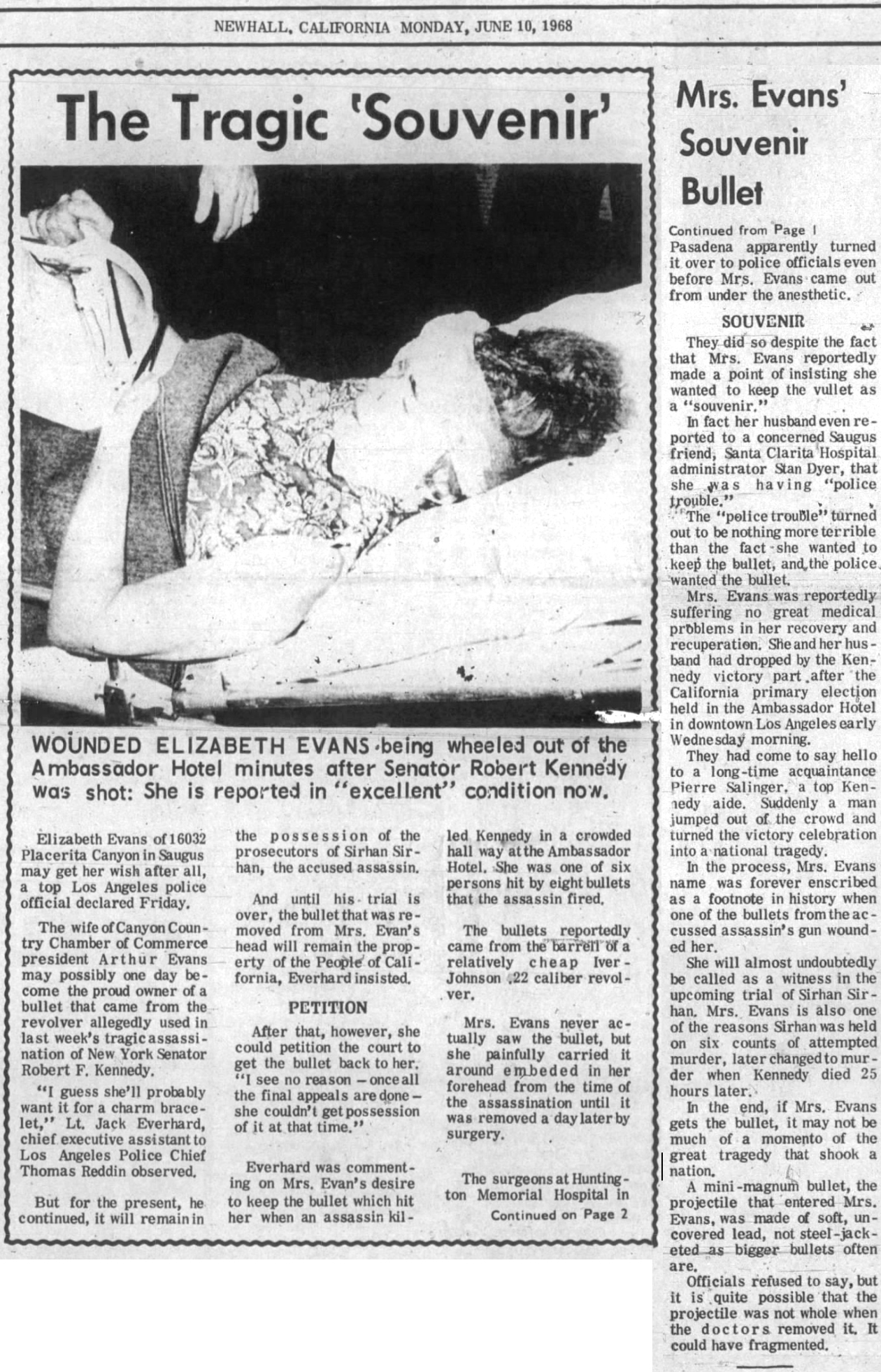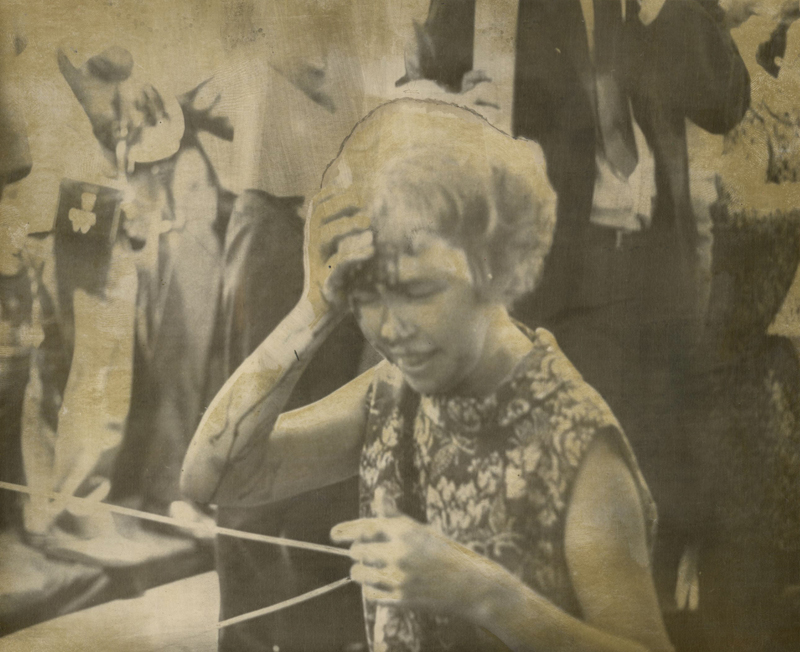(LA24)LOS ANGELES, June 5 [1968] — WOMAN GRAZED BY BULLET — Elizabeth Evans of Saugus, Calif., puts her handkerchief to her forehead which was grazed by a bullet at
the hairline during the shooting of Sen. Robert F. Kennedy in Los Angeles early today. (AP Wirephoto) 1968.
She wasn't just "grazed" — the bullet lodged in her forehead, where it remained until it was surgically removed the next day. See below.

Click image to enlarge.
The Newhall Signal and Saugus Enterprise | Monday, June 10, 1968.
Elizabeth Evans of 16032 Placerita Canyon in Saugus may get her wish after all, a top Los Angeles police official declared Friday.
The wife of Canyon Country Chamber of Commerce president Arthur Evans may possibly one day become the proud owner of a bullet that came from the revolver allegedly used in last week's tragic assassination of New York Senator Robert F. Kennedy.
"I guess she'll probably want it for a charm bracelet," Lt. Jack Everhard, chief executive assistant to Los Angeles Police Chief Thomas Reddin, observed.
But for the present, he continued, it will remain in the possession of the prosecutors of Sirhan Sirhan, the accused assassin.
And until his trial is over, the bullet that was removed from Mrs. Evans' head will remain the property of the People of California, Everhard insisted.
After that, however, she could petition the court to get the bullet back to her. "I see no reason — once all the final appeals are done — she couldn't get possession of it at that time."
Everhard was commenting on Mrs. Evans' desire to keep the bullet which hit her when an assassin killed Kennedy in a crowded hall way at the Ambassador Hotel. She was one of six persons hit by eight bullets that the assassin fired.
The bullets reportedly came from the barrel of a relatively cheap Iver-Johnson .22 caliber revolver.
Mrs. Evans never actually saw the bullet, but she painfully carried it around embedded in her forehead from the time of the assassination until it was removed a day later by surgery.
The surgeons at Huntington Memorial Hospital in Pasadena apparently turned it over to police officials even before Mrs. Evans came out from under the anesthetic.
They did so despite the fact that Mrs. Evans reportedly made a point of insisting she wanted to keep the bullet as a "souvenir."
In fact her husband even reported to a concerned Saugus friend, Santa Clarita Hospital administrator Stan Dyer, that she was having "police trouble."
The "police trouble" turned out to be nothing more terrible than the fact she wanted to keep the bullet, and the police wanted the bullet.
Mrs. Evans was reportedly suffering no great medical problems in her recovery and recuperation. She and her husband had dropped by the Kennedy victory party after the California primary election held in the Ambassador Hotel in downtown Los Angeles early Wednesday morning.
They had come to say hello to a long-time acquaintance Pierre Salinger, a top Kennedy aide. Suddenly a man jumped out of the crowd and turned the victory celebration into a national tragedy.
In the process, Mrs. Evans' name was forever enscribed as a footnote in history when one of the bullets from the accused assassin's gun wounded her.
She will almost undoubtedly be called as a witness in the upcoming trial of Sirhan Sirhan. Mrs. Evans is also one of the reasons Sirhan was held on six counts of attempted murder, later changed to murder when Kennedy died 25 hours later.
In the end, if Mrs. Evans gets the bullet, it may not be much of a memento of the great tragedy that shook a nation.
A mini-magnum bullet, the projectile that entered Mrs. Evans was made of soft, uncovered lead, not steel-jacketed as bigger bullets often are.
Officials refused to say, but it is quite possible that the projectile was not whole when the doctors removed it. It could have fragmented.
|
Elizabeth Evans was the first wife of Art Evans. (His second wife was also named Betty and served as president of the SCV Historical Society.)
From "The Life And Times Of Scott Newhall" by Ruth Waldo Newhall, Old Town Newhall Gazette, January-February 1996:
Scott wasn't the only ambitious publisher who sought to serve the growing community. He had the inside track, of course, having bought the existing 44-year-old weekly, but there were several challengers.
Most of them counted on the fact that Scott's flamboyant editorial policies annoyed many local citizens. The rival publishers ignored the fact that the customers had to read the Signal to be annoyed.
In an era where competitive newspapers were slowly dying out across the nation, there wasn't room for two papers in a community that had yet to count 20,000 residents.
Perhaps the greatest threat to the management of the Signal was Art Evans' weekly Sentinel.
Art was a popular and convivial Sand Canyon resident, with a variety of past experiences including some stints at newspapering. It was he who thought up the name "Canyon Country" to describe the eastern part of what had been included in "Saugus."
Art was seeking weapons to topple the Signal from its perch. Pointing to Scott's stand on the Vietnam War, he hinted in several editorials that Scott's views were dangerously Red. Scott replied by writing a front-page editorial, "I'm Calling You Out, Art Evans," and challenged him to a duel of words at high noon in front of the Valley Federal building, located at the strategic intersection of San Fernando Road and Railroad Avenue, the traditional entrance to downtown Newhall.
It was the week before Christmas, exactly 30 years ago. Scott and the Signal staff were stunned to see that stores and shopping had apparently been abandoned for the event. Sheriff's deputies were posted here and there around the curbs, apparently not believing that a duel would be limited to words.
Traffic was rerouted to Railroad and Newhall Avenues. Prominent in the front row of spectators was Sheriff Peter Pitchess. And standing alone in the middle of the street was Scott. The last thing he said before walking out was, "If the S.O.B. turns up full of cheer and dressed like Santa Claus, I'm beaten."
Art didn't show up. The Sentinel faded away. Not long afterward Scott invited Art to a private dinner, at which they found they agreed on nearly everything except whose paper should survive.
Art Evans died a few short years later. Scott delivered the eulogy at his memorial services.
AL1968: 9600 dpi jpeg from original AP Wire Photo, collection of Alan Pollack.




